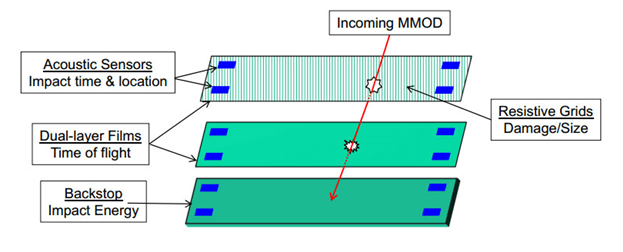I have blogged before about all the debris orbiting the Earth left over from space launches. It is estimated that there are more than one hundred million pieces of debris that are less than 1 centimeter in size. They are too small to track with radar, but some are still big enough to cause serious damage to a space craft because they are traveling so fast.
The International Space Station currently has special shields to handle orbital debris that is smaller than 1 ½ centimeters. Pieces that are larger than that can be tracked by ground-based radar. If they pose a sufficient hazard to the ISS, there are thruster attached to the ISS that can be used to move it out of the way of the debris.
A new Space Debris Sensor (SDS) has been developed. It will be used to monitor small space debris around the ISS. The system will be tested for two or three years. It will be recording debris between .05 millimeters and .5 millimeters. Any debris that is more than .3 millimeters will be tracked from the ground as part of the study.
The SDS will be delivered to the ISS as part of a SpaceX supply mission by December 12, 2018. It will be mounted on the Columbus module of the ISS and provide nearly real-time tracking and recording of small space debris.
John Hamilton, one of the principle researchers on the SDS project said, “Debris this small has the potential to damage exposed thermal protection systems, spacesuits, windows and unshielded sensitive equipment. On the space station, it can create sharp edges on handholds along the path of spacewalkers, which can also cause damage the suits.”
The SDS has three layers. It is able to record the size, speed, direction and density of the small objects in the debris cloud. The debris penetrates the first two layers which are identical. Each contains acoustic sensors and resistive lines which are .075 millimeters wide. They provide information on the time, location and speed of the particles. The final layer is made of Lexan which stops the particles and records their density. None of the captured particles will be recovered but the SDS does provide important information.
Hamilton said, “The backstop has sensors to measure how hard it is hit to estimate the kinetic energy of the impacting object. By combining this with velocity and size measurements from the first two layers, we hope to calculate the density of the object.”
The information gathered by the SDS system should allow the researchers to create a detailed map of the entire orbital debris cloud at that altitude. They will be able to plan for the placement of future sensors beyond the ISS and low Earth orbit where there is greater risk of damage from orbital debris.
Hamilton said, “The orbital debris environment is constantly changing and needs to be continually monitored. While the upper atmosphere causes debris in low orbits to decay and either burn up of fall to Earth, every new launch and new event in space will add to the cloud of debris.
Space Debris Sensor diagram:
